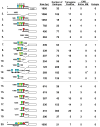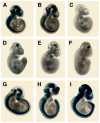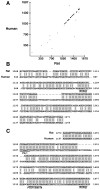Heterogeneity of neural progenitor cells revealed by enhancers in the nestin gene
- PMID: 9917366
- PMCID: PMC3938161
- DOI: 10.1006/dbio.1998.9035
Heterogeneity of neural progenitor cells revealed by enhancers in the nestin gene
Abstract
Using transgenic embryos, we have identified two distinct CNS progenitor cell-specific enhancers, each requiring the cooperation of at least two independent regulatory sites, within the second intron of the rat nestin gene. One enhancer is active throughout the developing CNS, while the other is specifically active in the ventral midbrain. These experiments demonstrate that neural progenitor cells in the midbrain constitute a unique subpopulation based upon their ability to activate the midbrain regulatory element. Our finding of differential enhancer activity from a gene encoding a structural protein reveals a previously unrecognized diversity in neural progenitor cell populations.
Copyright 1999 Academic Press.
Figures





References
-
- Bayer SA, Wills KV, Triarhou LC, Ghetti B. Time of neuron origin and gradients of neurogenesis in midbrain dopaminergic neurons in the mouse. Exp Brain Res. 1995;105:191–199. - PubMed
-
- Brüstle O, Maskos U, McKay RD. Host-guided migration allows targeted introduction of neurons into the embryonic brain. Neuron. 1995;15:1275–1285. - PubMed
-
- Campbell K, Olsson M, Björklund A. Regional incorporation and site-specific differentiation of striatal precursors transplanted to the embryonic forebrain ventricle. Neuron. 1995;15:1259–1273. - PubMed
-
- Clarke SR, Shetty AK, Bradley JL, Turner DA. Reactive astrocytes express the embryonic intermediate neurofilament nestin. NeuroReport. 1994;5:1885–1888. - PubMed
Publication types
MeSH terms
Substances
Associated data
- Actions
- Actions
Grants and funding
LinkOut - more resources
Full Text Sources
Other Literature Sources
Medical
Molecular Biology Databases

